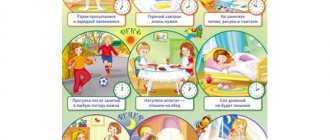A daily routine is a set sequence of sleep, walks, games, developmental activities, nutrition, and hygiene. When a child begins attending kindergarten, the question arises of preparing him for classes at school: the child needs to develop skills in using a pen and pencil, as well as perseverance, the ability to concentrate, and carry out the tasks of the teacher (educator, and then teacher). A preschooler’s well-established daily routine helps with this – and more.
What should the regime be?
The importance of a daily routine for preschoolers is difficult to overestimate. It has been established that children who follow a daily routine are more balanced and productive. They gradually develop certain biorhythms, as well as a system of conditioned reflexes. All this helps the small organism physiologically switch between one or another type of activity, prepare in a timely manner for each stage: eating, walking, exercising, resting.
In the absence of a stable regime, the nervous system of a preschooler experiences great stress: the baby quickly becomes overtired or overexcited, and accumulated fatigue prevents proper sleep. Children with developmental disabilities feel this especially acutely, since their body’s reserves are often reduced.
What does a harmonious daily routine for a preschooler look like? It includes the following periods.
- Night sleep. For younger preschoolers it should last 13–14 hours a day, for older ones – about an hour less. Babies should be put to bed at night between 20 and 21 hours.
- Daytime sleep. Before 4 years of age, its duration is about 2 hours, after - about 1.5 hours.
- Meals. There should be at least 4 of them, every 3.5–4 hours.
- Stay awake for 6–6.5 hours.
Approximate daily routine for two children for one day
When planning a daily routine for children, pay important attention to how many periods of sleep the youngest child has. If other points can be easily adjusted, then sleep is the factor that is the basis for creating a routine for both children.
It is best if the child’s daily routine at home coincides with his routine at the preschool. We will give approximate daily routines in the tables for the mother of preschool children who have switched to one nap, and the daily routine for the mother of children the same age, the youngest of whom still sleeps twice a day.
Daily routine table for preschooler and toddler
Table of daily routine for mothers of preschoolers over one and a half years old
We will also write about how to put children to bed at the same time, or, more difficult, to put them to bed one by one in a checkerboard pattern, and you can read about tricks to help organize and save time in the article “How to cope with two children alone.”
If it is possible to combine your baby’s sleep with his first walk, feel free to combine it. If the children willingly develop together, give it the go-ahead, but if the younger one interferes with the creative and concentration-requiring activities of the first-born, it is better to schedule them during the baby’s sleep time, or independently occupy the younger child during this time with an interesting toy that is appropriate for his age. Try to sense your children's needs and balance their sleep and wake schedules in a way that works for the whole family.
What does it mean to be awake?
This is not just a period when the child does not sleep. The wakefulness of a preschooler attending kindergarten is filled with a variety of useful activities:
- walks (in winter - about 3 hours, in summer - up to 6);
- study of the surrounding world;
- physical activity;
- speech development classes;
- work activity;
- classes or games on mental development (mathematics, learning to read, logic, development of attention, memory), moral education;
- creative activity;
- music lessons;
- teaching writing skills.
Such activities directly contribute to the development of qualities that a child will definitely need at school: initiative, perseverance, concentration, activity, motor skills, curiosity, and the ability to withstand a certain amount of time at work.
For younger schoolchildren in kindergartens, up to 10 different classes are provided per week, for older students - up to 14.
At the same time, activities aimed at teaching children are planned between 9 and 12 o'clock in the morning, between 16 and 18 o'clock in the evening. This is due to the level of performance and activity of preschoolers during the day. The most unfavorable period for learning is between 12 and 16 hours.
When drawing up a lesson schedule, the degree of difficulty is also taken into account. The more complex ones include mathematics, speech development, studying the world around us, while the simpler ones include drawing, modeling, appliqué, and design. The most complex ones are planned in the first half of the week, when children are more productive, and the simple ones - in the second half. Static activities are combined with dynamic ones (walking, gymnastics, music classes).
Educational activities are structured taking into account age capabilities. The duration of one lesson for younger preschoolers is about 15 minutes (there should be no more than 2 per day), for older ones - up to half an hour (2-3 developmental classes are held daily).
Don't overdo the sections or circles. For a kindergarten-preschooler, 1–2 clubs are enough. He should have time to rest and communicate with his family. Excessive developmental workload will lead to overstrain of the nervous system, sleep disturbances, and a decrease in the body's immune defense.
Approximate schedule
The daily routine of preschool children who go to kindergarten is subject to the work program of a particular institution. It might look something like this:
- 7:00 – 8:00 – getting up, exercising, morning hygiene, going to kindergarten;
- 8:00 – 8:30 - breakfast;
- 8:40 – 10:00 – gaming and educational activities;
- 10:10 – 12:10 – walk, games;
- 12:30 – 13:10 - dinner;
- 13:10 – 13:30 – preparation for daytime sleep;
- 13:30 – 15:30 - dream;
- 15:30 – 16:00 – awakening, quiet games;
- 16:00 – 16:30 – afternoon snack;
- 16:30 – 17:30 – educational activities, games;
- 17:30 – 19:00 – a walk, the way home, playing outside;
- 19:00 – 19:30 - dinner;
- 19:30 – 20:30 – quiet games;
- 20:30 – 21:00 – bathing, preparation for bed;
- 21:00 – 7:00 - night sleep.
The child spends the evening at home. Therefore, it is important for parents to remember that the child’s activities before bed should not be too noisy or active. You can read books, draw, play with blocks or construction sets, and discuss the past day.
If your preschooler attends kindergarten, try to adhere to the routine established at the preschool on weekends. This will allow the child to be more productive in activities by the beginning of the next week. If your child does not yet attend preschool, but you plan to send him there in the foreseeable future, find out the schedule of a particular kindergarten and teach your child to it while he is at home. Then it will be much easier for him to adapt to life in a children's group.
ABC of the regime
There are rules in all areas of our lives, and they also exist in observing the regime. As we said above, there is a diet for preschoolers, physical activity, sleep, games, and activities.
Diet. If we are talking about proper nutrition, then the regime is most accurately followed in preschool institutions, so it is worth focusing specifically on the organization of nutrition in kindergarten:
- at least 4 times a day;
- a hot meal at least 3 times a day;
- according to daily caloric needs: breakfast 25%, lunch 40%, afternoon snack 15%, dinner 20%;
- according to the daily calorie intake: 5 years - 2000 kcal, 6 years - 2200 kcal, 7 years - 2400 kcal;
- by quantity - you should not give a portion larger than the child usually eats (it is better to add a supplement).
The menu should include meat and dairy products, bread, vegetables and fruits every day.
In terms of time, the mode is built like this:
- breakfast at 8-9 o'clock,
- lunch at 12-13 o'clock,
- afternoon tea at 15-16 hours,
- dinner at 18:30-19:30 hours.
Meal times should be the same on weekdays and weekends.
It is advisable that the last meal be an hour and a half before bedtime.
Mode of physical activity and rest. Every day a child makes many movements, so physical activity means not only physical education, but also active games, sports, movement and relaxation. And here, too, there is a regime that ensures proper physical development.
- The peak of physical activity should occur in the first half of the day.
- Weekly physical activity for children 5-7 years old is 6-8 hours per week, according to SanPiN.
- Morning exercises are required.
- Physical education classes in a preschool institution - 3 times a week: children 5 years old - 25 minutes, children 6-7 years old - 30 minutes.
- Outdoor active games while walking (in bad weather they are replaced by a full set of exercises indoors).
- Physical education minutes between mental activities.
- Exercising after a nap.
- Moderately active games on the second walk.
Moderate physical activity should be observed immediately before breakfast, before mental activities and in the evening before bed.
Sleeping mode. A proper sleep schedule helps restore your baby's mental and physical strength that was spent on the active part of his day. Not only his psycho-emotional state, but also his physical health depends on how a child’s sleep is organized. Healthy sleep means strong immunity. And now, in order.
- Sleep duration for preschoolers: 5-6 years old - 12 hours, 7 years old - 10-11 hours. But much is individual - depending on temperament and workload, the required time for sleep may increase.
- Morning awakening should occur at 7:00-8:00, it depends on biorhythms and family habits, but you should not wake up later.
- Daytime sleep in children 5-6 years old lasts 1-1.5 hours. At 7 years old, a baby may refuse to sleep, but active children need about 1 hour of sleep.
- Evening bedtime depends on the presence of additional physical or emotional stress. It is recommended that children aged 5-6 years go to bed at 20:30 - 21:00. At 7 years old it is possible to shift the time of falling asleep by half an hour.
Mode of exercise (mental activity) . Both kindergarteners and children who do not attend kindergarten are not deprived of developmental activities in preschool age. But like any other activity, the time and number of classes must be correctly distributed and systematized. In other words, the home regime should not differ much from the regime in preschool institutions. The organization of classes in the general daily routine is as follows:
In the morning after breakfast - two or three multidirectional classes. Duration of classes according to age: 4-5 years - 20-25 minutes per type; 6-7 years - 30-35 minutes.
If the walk is cancelled, you can add another creative activity or educational game.
Home mode
What should you do if, for some reason, your child does not and will not attend kindergarten? Sticking to the same regime is a definite thing. True, with some nuances. The first of them is that the baby can be allowed to wake up a little later (since there will be no time needed to travel to the kindergarten). Secondly, you can also put the baby to bed later.
Another subtlety is that parents will have to organize educational activities for their child themselves. To do this, it is advisable to familiarize yourself with the requirements for preparing a child in the school that the child will attend in the future, and try to prepare the child in accordance with them. Of course, you can also attract specialists to help (for example, enroll your child in an early development group or with a teacher who will take on the role of a kind of tutor). But if you have confidence in your own abilities, then it is better if the parents teach the preschooler. This way they will have the opportunity to once again (which is not at all superfluous!) demonstrate to him their love, interest in his development and pride in his first achievements.
You will have to do the same things as in the garden: teach writing, reading, drawing, sculpting, dancing, teaching basic mathematical concepts, developing speech, studying nature, playing, developing the child physically (independently or in a sports section), and be sure to accustom him to work. Among other things, mothers are entirely responsible for their child’s diet.
Lesson notes on OBP “What is the daily routine?”
Circle:Each child has a flower in his hands. The teacher passes the flower with a wish to the child, and he passes it to the next one; the bouquet gradually increases, and a whole bouquet is returned to the teacher - a bouquet of wishes. Wish health, wish goodness to others, and it will definitely come back to you!
Conversation:
Nature has its own mode of life, its own laws of life. Nature maintains a certain order in its life, and this order is called “Seasons”. List them.
Man is a piece of nature, and he must maintain order in his life, must lead a certain, correct way of life. The order in which a person lives is called “daily routine”. It is observed by both adults and children, especially those who want to grow up healthy. Today we will play a game - the journey “Daily Mode”. And what is it?
- That's right, this is a daily and life routine that helps us do everything on time: study, play, walk, and relax. It saves us from fatigue and overload, strengthens our health. Get in the column! Let's go on a train journey.
A steam locomotive has been waiting for us for a long time - Two pipes and a hundred wheels.
Steam locomotive, steam locomotive - he carried the carriages.
Station 1 “ The morning begins - the sun wakes up”
-To wake up in a good mood, you need to go to bed on time. When we wake up in the morning, what do we do?
-Do you know how to wake up correctly?
1. Stretch 2. Place your right leg and stand 3. Smile
-Why do you think I should smile?
Musical game " Stretch"
-What do we do next? That's right, let's wash ourselves. I'll check now, do you know what supplies are needed for morning toilet?
Game
“Find and Show”
- Well done, washed your face! I hear the porridge puffing on the stove.
Breathing exercises “Porridge”
IP: sitting, one hand lies on the stomach, the other on the chest. Drawing in your stomach and drawing air into your lungs - inhale, lowering your chest (exhaling air) and sticking out your stomach - exhale. When exhaling, pronounce the sound “f-f-f-f” loudly. Repeat 3-4 times.
Station 2: “ Healthy eating – great mood”
-We have arrived at the next station and will stay there for a bit and play.
Relay game “ Healthy food”
Station 3: Dienesh blocks d/i " Architects"
-We had breakfast and arrived at the Shkolnaya station. What do you do in class at school? That's right: you draw, count, sculpt, and learn a lot of new and interesting things. You and I are architects, we will build a house according to the plan.
—So we played and went for a walk.
Guys, lunch is waiting for us - both compote and vinaigrette!
p/game “ Vegetables and fruits”
Place two pans in two hoops: “Vinaigrette” and “Compote”. Lays out pictures depicting various products.
Station 4 " Quiet hour"
-And now we’ll go to bed, Let’s breathe through our noses.
- Guys, what do you think, do animals sleep? Do they need sleep? For what? Do you know how animals sleep? Is everything the same? Let's look at the photos.
Giraffe Owl Squirrel Horses Birds Puppies
- Well, guys, wake up and toughen up quickly!
-After sleep, we relax and play different games!
p/game " Two Circles"
(To the music, they run scattered through the group. When the music stops, line up in 2 circles)
After school, the children go home, play, and do their homework. Let's remember the familiar letters and write them on the board.
Lacing game
In the evening we go home, have a light dinner before bed.
We take a bath and put on pajamas.
Night covers the earth - the son and daughter fall asleep.
-What do you think, is everyone’s sleep duration the same?
-Some animals, such as marmots and bears, hibernate in order to accumulate more energy for an active life, which they will begin with the arrival of spring. And with the arrival of winter, squirrels sleep more than at other times of the year. Does a person need sleep? For what?
-Remember how you felt when you didn’t sleep well at night? Those people who get a good night's sleep live longer than those who are constantly sleep deprived. During sleep, children's bones also rest, thanks to this, they grow better. It’s not for nothing that they say that children grow up in their sleep.
-Do adults and children sleep at the same time? Who can say how long very little ones ( infants)
children? But in order for the sleep to be complete, you need to follow certain rules.
Psycho-gymnastics
“Dream”
A dream comes to visit us. He calls you to his bed.
Sleep, baby, it’s sweet, sweet, Everyone sleeps at night, even during the day.
We'll rest a little. We were too tired after half a day,
We need to take a break.
Result:
Now please sit down at the tables and draw your best dream. And then you tell everyone about your dream. Our Daily Routine journey has come to an end. I wish you to always be cheerful and healthy. Praises children.
We teach to study
This is where the biggest difficulty awaits parents. Children are used to it and love to play. But learning for them is something incomprehensible in principle, and therefore boring and unnecessary. In a group of peers, children study together, which is an additional incentive. In addition, experienced teachers know how to find an approach to children and interest them in the upcoming work. But how can you explain to your child at home what the point is in learning?
Most of us will start to scare the child with the fact that “ignoramuses, when they grow up, work as janitors or loaders.” To a child, such a prospect seems very distant and vague. And besides the fact that he will devalue the work of a loader or janitor for himself, such suggestions will be of no use.
The second option, and also not the best, is bribery: if you read it, you will receive a toy, sweets, or play on the computer. This approach will only create commodity-money relations between the preschooler and adults. The baby will not be interested in the result of his work. It will be important for him to quickly finish what is preventing him from having fun and get the desired reward.
How can you help your child accept the need for classes?
- Appreciate all your child’s achievements: both existing and upcoming ones. Teach it to teach, and not to satisfy your unfulfilled ambitions.
- Don’t cram as much knowledge into it as no one knows everything. First of all, take into account what is interesting to the child himself, comparing with the requirements for readiness for school.
- Do not compare your own child with others who are more successful - this will lower the child’s self-esteem and discourage the desire to learn. Compare with how he himself is progressing.
- You cannot buy the efforts of a preschooler with some benefits, just as you cannot force him to study as a punishment for wrongdoing.
- You cannot punish for mistakes or inability. Parents are helpers, mentors and advisers.
- Always praise your child for any successes, support him, show your pride in his successes and faith in his strength.
- Difficult tasks cannot be excluded. They are most useful for the development of the baby. Just show him that you are always ready to help.
- Stick to the established time of classes, observe age standards for their number per day and duration.
- Diversify your lessons with fun physical education breaks so that your child doesn’t sit too long and get tired.
The daily routine of a preschooler is aimed, first of all, at his development and preparation for learning. Therefore, it is so important to draw it up correctly and strictly adhere to it. This habit will help the child throughout his life. It will make him more confident, organized and productive.





